
|   |

|   |
Bombay Diary - Veejay Sai e-mail: vs.veejaysai@gmail.com May 31, 2014 Sindhu Festival 2014 Bombay, as I prefer calling the city that is now known as Mumbai, isn’t where one would expect a lot of art and cultural events taking place. The dance community here isn’t really the most recognized or popular one among the various arts communities that spot the city’s cultural life. Especially in a city where the blaring noise of the Hindi cinema and television industry has managed to drown out everything else, including very own local Marathi industry, performing arts are the last on the block. Even among the performing arts community, the theatrewallahs and classical musicians rule the roost while the small but significant community of dancers continues to struggle for consistent patronage. In that light, the Sindhu Festival of dance established by Bharatanatyam dancer Vaibhav Arekar and Kathak dancer cum lighting expert Sushant Jadhav is highly commendable. Over the last three years, it has marked itself significantly on the city’s cultural calendar as an event that is not to be missed. 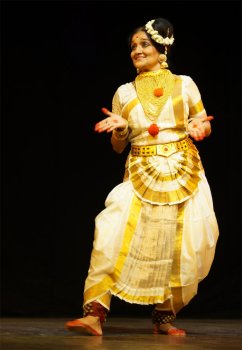 Mandakini Trivedi 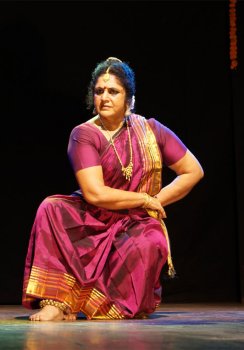 Chitra Visweswaran The day one of the festival titled ‘Abhinaya Sandhya’ is dedicated to present shows of good abhinayam. In the last few editions, several legendary dancers like Guru CV Chandrashekar and Dr. Kanak Rele have regaled audiences. This year’s edition opened with a Mohiniattam performance by Mandakini Trivedi. In her own inimitable style Mandakini (everyone in Bombay calls her “Manda Miss”) has grown into her own interpretation of the dance form. Drastically cut off from the mainstream version followed religiously in Kerala, like her guru Dr. Kanak Rele, Mandakini’s dance was good in patches but somehow failed to convince the depth of the content of the items she chose to perform. Going by her own style one could say this dance was more of a ‘Mandakini Attam’ deviating from the traditional Mohiniattam. The second performance for the evening was a solo by Guru Chitra Visweswaran. Firstly, it was fantastic seeing Chitra perform after a long hiatus. Added to this, Chitra chose to perform some fine abhinayam pieces. 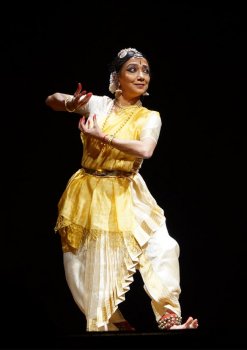 Leela Samson Next evening Vaibhav’s own choreographic jugalbandi with Odissi queen Sujata Mohapatra was noteworthy. With amazing chemistry and precision, they weaved together excerpts from Jayadeva’s ‘Geeta Govindam’. They make for a great dancing couple for sure. While Sujata’s expertise in Odissi is well known, it was a great experience to see Vaibhav successfully strive to match his Bharatanatyam to her graceful movements. Following that was a presentation by Spanda dance ensemble with Leela Samson at the helm of affairs. With some excellent lighting, the group of dancers formed rhythmic patterns to celebrate abstraction within a set form utilizing traditional motifs from Bharatanatyam. Bombay got an excellent glimpse of Leela’s abhinayam in her solo presentations of ‘Kalabhairava Ashtakam’ and a javali “Era rara.” That day we also celebrated the 52nd year of Guru Chitra Visweswaran’s innings onstage since her arangetram. Half a century on stage! Over cake and laughter she recollected her debut performance and how the very dance form has changed so drastically over the decades. 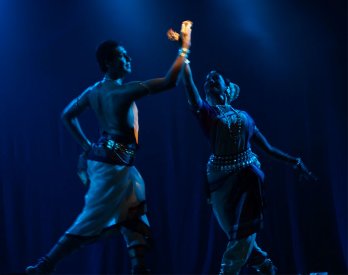 Vaibhav Arekar and Sujata Mohapatra 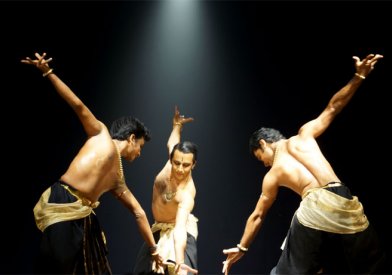 Spanda Vaibhav’s own group choreography on the subject of songs of the saints from the Varkari tradition of Maharashtra was thoroughly enjoyed by the audiences. With a little more sophistication and rethinking the choreography, this presentation could be toured across the country. The third day of the festival ended in an anti-climax of sorts with a tedious presentation called ‘Nishabdha Bedha’ by Pune-based Shama Bhate and her group of Kathak dancers. Shama was inspired by a rather somber French documentary titled ‘Le Monde Du Silence’ on marine life conservation. Excerpts from the documentary that was screened at the far end of the stage was juxtaposed with Shama’s own choreography that seemed to be strongly disconnected. Her group danced the regular Kathak sans ankle bells and imitated everything from dying fish to sea anemones. While trying hard to catch a ‘Samm’ in silence, the abrupt cutting of sequences made the whole presentation feel like a desperate patchwork of an idea that wasn’t probably thought over well enough to be implemented. The most watchable parts of the presentation were where the sitar and tabla music dictated the movement in the choreography and not the silence. We saw fishes doing ‘Tatkaar’ and counting the usual chakkars to Ek-do-teen-chaar-paanch and whatever else could be managed from this. The music, generously borrowed from various albums cut by artistes like Dr. L. Subramaniam, Ustad Ali Akbar Khan and the like was the only saving grace for the show. If Shama can redesign this work, it might stand a chance to be of any worth or consequence, especially the social cause of marine life she chose to convey. Thus another year of the Sindhu festival concluded successfully. Cityscapes on stage 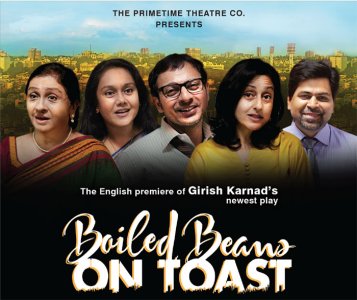 Boiled Beans on Toast 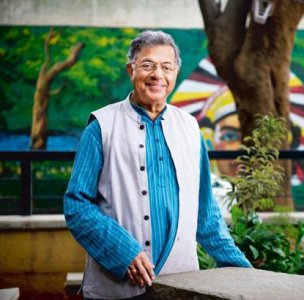 Girish Karnad At the world premiere of Girish Karnad’s latest play ‘Boiled Beans on Toast’ directed by Lillete Dubey at the NCPA’s Tata Hall, one saw a wonderful gathering of the city’s theatrewallahs in large numbers. ‘Boiled Beans on Toast’ is a spinoff of the Kannada name ‘Bendekaloor’ that the modern word ‘Bangalore’ routes itself in. Unlike most of his older plays that have often dealt with history, folklore and mythology, in his current play, Karnad explores a more modern subject. In fact the last couple of plays that he wrote, ‘A Heap of Broken Images’ and ‘Wedding Album’, both deal with themes very different from his older work. In the current play, the idea of a city and the drastic role it has on citizens’ lives was explored in a wonderfully presented non-linear narrative. The city space is Karnad’s canvas and the numerous lives affected by the ‘cityness’ are his characters. The play was a collection of plots, each of them complete in their own respective spaces. These come together in an urban confluence that a city life and power structure dictates. These plots meet at some point and weave into each other but each one has an individual story to tell of how they have designed their lives in Bengaluru. Each of the characters were colorfully sketched to show how wide a variety of citizenry urban India can accommodate. A domestic help’s struggle for survival, an urban educated dissatisfied youngster with hopes for better employment, an opportunistic manipulator, a concerned social worker, the policeman and who have you! Lillete Dubey managed to gather all this complexity into her directing. However, out of the few things that did not seem to fall in place was the way in which languages were used. English isn’t the best of language to reflect on the class structure, politics and conflict of identities within a city space. Several times in the course of the play one felt how else could the director have managed the complexity of these characters and the script in general. Joy Sengupta’s versatile acting was noteworthy. With this play, Karnad gets a step closer and grabs the pulse of the younger and more confused generation of urban Indians. While Lillete’s direction of the play came across as a work in progress, the play in itself is certainly a must watch! Sweet Cyborg songs 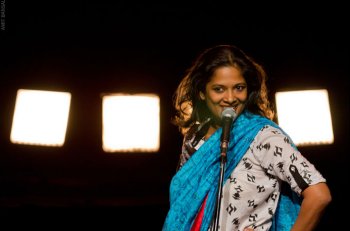 MD Pallavi Photo: Amit Bansal 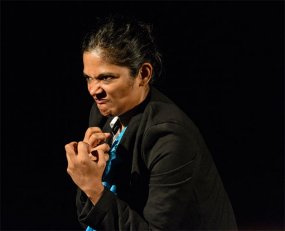 MD Pallavi Photo: Mike Wilfling One must say that out of all the three communities of performing arts in India, i.e. music, dance and theatre, the theatre audiences come to watch any show unbiased. The classical music community is often ruled by their favoritism towards a certain Gharana or musician. Within the classical dance community, we have often seen how students don’t turn up to show support to their own guru’s productions either and many gurus also restrict their students from going out and watching other dance performances. Theatre community somehow seems to have gone beyond all this and evolved itself as a more united one. And this show of community strength was displayed at the Prithvi Theatre at a special staging of Sophia Steff’s ‘C Sharp C Blunt’ organized by the Goethe Institute and the Max Muller Bhavan. The text written by young playwrights Swarnalata Thounaojam and Irawati Karnik create a cyborg Shilpa. She is a Smart phone downloadable application in a world obsessed with technology and will sing the way you want her to with a clear menu that gives you directions to dictate your terms. Shilpa asks the audiences to choose on a scale of 1 to 10, the voice quality based on categories of sweetness, huskiness, sexiness and flexibility and so forth. Shilpa is also in other roles in the play, a struggling actress who wants to make it big in the industry, a director shooting a rape scene and a virtual character in a video game. The sub-narrative explores what it takes to be a woman in the entertainment industry today. While story in itself came across a bit scattered, what stood out and kept the whole flow intact was MD Pallavi’s stellar singing and acting. She really holds forth with her singing, versatile voice modulation and playing impromptu in the sections that involve audience interactions. What else! The play won the award for the best at this year’s prestigious META awards held in Delhi earlier this year and Pallavi won the award for being the best actress. Well-deserved! Going by the current Indian theatre scene, one can easily say that MD Pallavi is one of the finest and best singing stars we have. Kudos to the director for rightly utilizing Pallavi’s singing talent the right way! Mere paas maa hain! This year’s Mudra Dance Festival at the NCPA was themed around mothers and daughters. Great theme! Under the aegis of Swapnokalpa and her team, NCPA’s experimental theatre hall saw lines queuing up for every performance! Though I couldn’t catch up for the initial parts of the festival, I managed to watch two of the big shows that premiered in this festival. The first one was the Delhi-based mother-daughter duo of Rama Vaidyanathan and her daughter Dakshina Vaidyanathan performing Bharatanatyam. One must really congratulate Rama for training Dakshina to perform with such finesse. They performed some traditional and some choreographed pieces using the whole idiom of the Bharatanatyam vocabulary. Towards the end of the performance, as celebration of the theme of the festival, Rama’s octogenarian mother Madhavi Gopalakrishnan, a Sanskrit scholar and guide in her own right, was invited on the stage and the audiences got to interact with them. Rama’s mother’s stories of how a performance of Yamini Krishnamurthy inspired her to decide on Rama being a dancer and so on were highly amusing and inspiring. 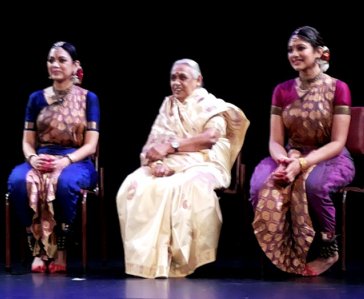 Rama, her mother, Dakshina Photo: Veejay Sai 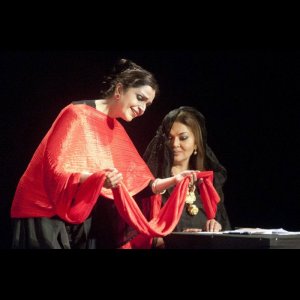 Anita Ratnam and Malavika Sangghvi Photo: Narendra Dangiya ‘Circles of Love’, a poetic dance-theatre presentation between Anita Ratnam and Malavika Sangghvi was a delight to watch not just for lovers of dance but poetry too. Anita’s performance using Matryoshka dolls as a metaphor to represent various generations of mother-daughter relationships in her own family elevated the entire choreography along with her excellent sense of costuming to suit the acts. Added to that, the powerful script and excellent lighting by Victor Paulraj created a completely different contemporary dance experience. Added to this was the subtle live music by the young and talented Vedant Bharadwaj and his singing guitar. Using various techniques of theatricality, Anita smartly weaved in everything from personal stories to political statements and made the performance engrossing. Malavika’s poignant poems dedicated to her mother touched an emotional chord with the audiences. In addition to her own poems she also read out other famous works of poets like Nissim Ezekiel. One would have wished to hear some more stories about Malavika’s mother too as a part of the entire production. This fantastic collaboration between a seasoned dancer and a poet, with a little re-working in its narrative structure, could easily tour many festivals. Knowing Anita with her many past works, she will soon morph it into another of her presentations with an international quality and touch to it. NCPA’s festival was hugely successful and one must congratulate the team behind it. Hope they become more inclusive in their programming and open their doors to many more talented youngsters. Where is my award Towards the end of my stay in Bombay, I decided to call on the nonagenarian Kathak diva Sitara Devi. While she said there was nothing left to write about her or her dance anymore, she strongly advised me to write articles saying she wanted the Bharat Ratna Award. Mind you, she wasn’t kidding or beating around the bush one bit. Very nonchalantly she asked the award like anyone would ask for a glass of water! While I did take Sitara Devi’s phone call with a big pinch of salt, it did come to my mind that she might have a point somewhere. It must be brought to notice that till today no dancer has ever received India’s highest civilian honour. Musicians, yes! Scores of them! Dancers? None! We have several nonagenarian dance veterans in the field. Mrinalini Sarabhai, Amala Shankar and Sitara Devi in addition to many more gurus like ace choreographer Dr Maya Rao, CV Chandrasekhar, Kalamandalam Gopi and Pt Birju Maharaj. While some of them have been Padma awardees, not all of them have gotten their due recognition and certainly a Bharat Ratna is long overdue to the dance community. Time to get the community act together! Adios, Amigos! Veejay Sai is a writer, editor and a culture critic. |